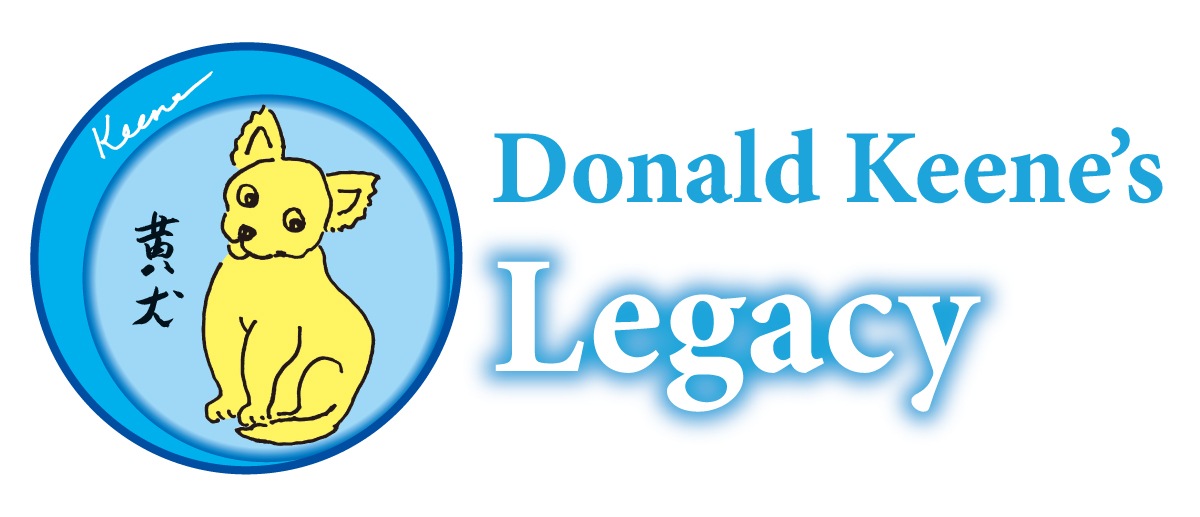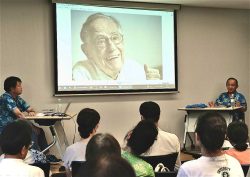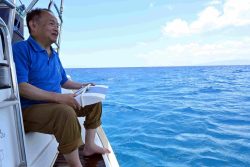Soka City Keeps Up Cultural Dialogue Started by Donald Keene; Family Members Share Memories of His Later Life
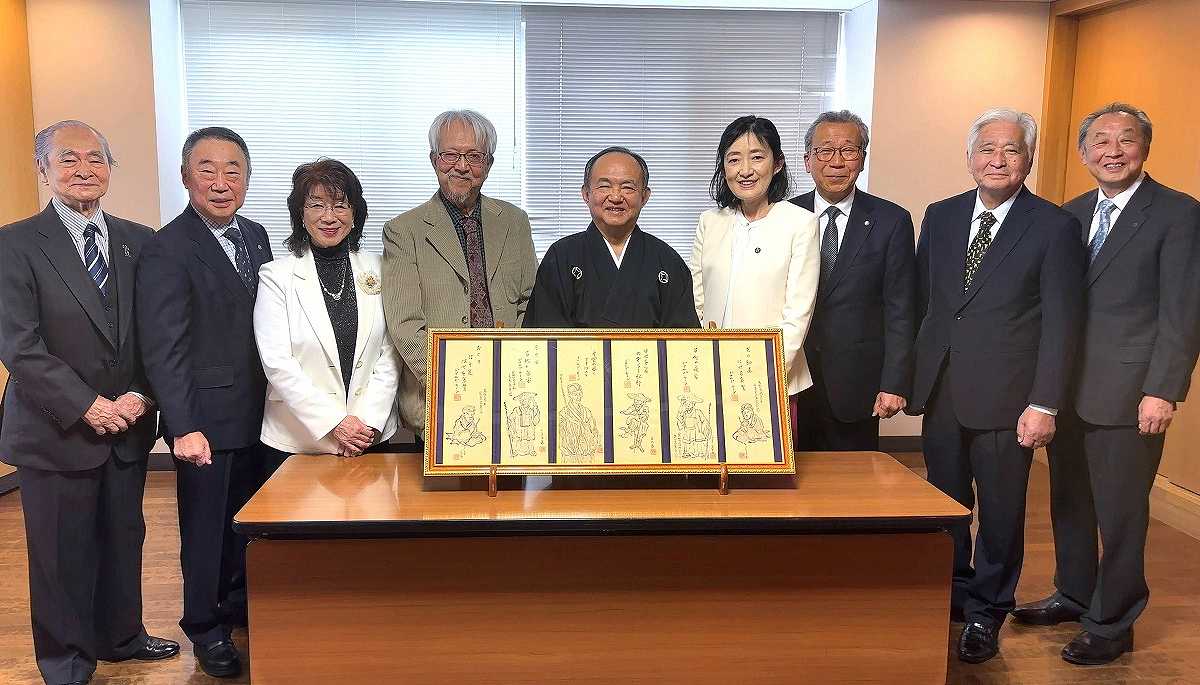
Seiki Keene (center) and Kiro Uehara (center left) stand behind donated artworks with people from the Soka municipal government. Mayor Yuriko Yamakawa is at center right.
14:54 JST, March 5, 2024
Seiki Keene, adopted son of the late literary scholar Donald Keene, held a public talk in Soka, Saitama Prefecture, on Saturday with his brother, the painter Kiro Uehara, to share memories of the elder Keene’s daily life in his later years.
Soka, north of Tokyo, is among the locales that appear in Matsuo Basho’s “Oku no Hosomichi” (“The Narrow Road to Oku”), Japan’s most famous haiku travelogue and a major literary work of the Edo period (1603-1867).
Keene studied Basho (1644-94) and published translations of his work. This led to an exchange between Keene and the people of Soka, echoes of which continue even after Keene’s death five years ago at the age of 96.

Seiki Keene gives a shamisen storytelling performance.
About 70 people gathered at the Soka City Culture Hall, where a kimono-clad Seiki, 73, began the event with an about 10-minute shamisen storytelling performance. Seiki, a retired professional shamisen player from the Bunrakuza puppet theater, energetically sang a part of the “Oku no Hosomichi” that describes Basho’s journey from Edo, now Tokyo, through Soka to Nikko, in what is now Tochigi Prefecture, and was met with loud applause.
“My father slept on a futon, not in a bed.” In his talk after the performance, Seiki shared his memories while projecting photos of Keene in his daily life onto a screen. Seiki was adopted in 2012 and lived with Keene in his later years. He said: “Breakfast was usually hazelnut coffee, which he bought at a supermarket in New York, with croissants and seasonal fruits. He was especially fond of papaya with a squeeze of lime.”
Even in his 90s, Keene chose wine by himself at the supermarket, enjoyed music, and went into his study each evening after dinner for “benkyo” (study). Seiki recalled, “The remarkable thing was his concentration. He was so absorbed in his studies that he sometimes didn’t notice when I called out to him, and sometimes he stayed up until 1 a.m.”
“Keene became good friends with our cat, Mona Lisa,” Uehara, 75, recalled of Keene’s visits to the brothers’ hometown of Niigata City several times a year. Keene always stayed in the Ueharas’ traditional Japanese-style house for several days, and Uehara always served him sashimi dishes using Niigata’s local fish, which Keene liked.

Donald Keene and the cat Mona Lisa projected on a screen at the venue
“Mr. Keene used to give me books in the beginning. However, from about the third time, they were addressed to Mona Lisa. Postcards from overseas were also addressed to Mona Lisa, with messages like, ‘I think of you often.’ And at the end, it says, ‘Best regards to your master.’” The room was filled with laughter as Uehara introduced such humorous episodes about Keene.
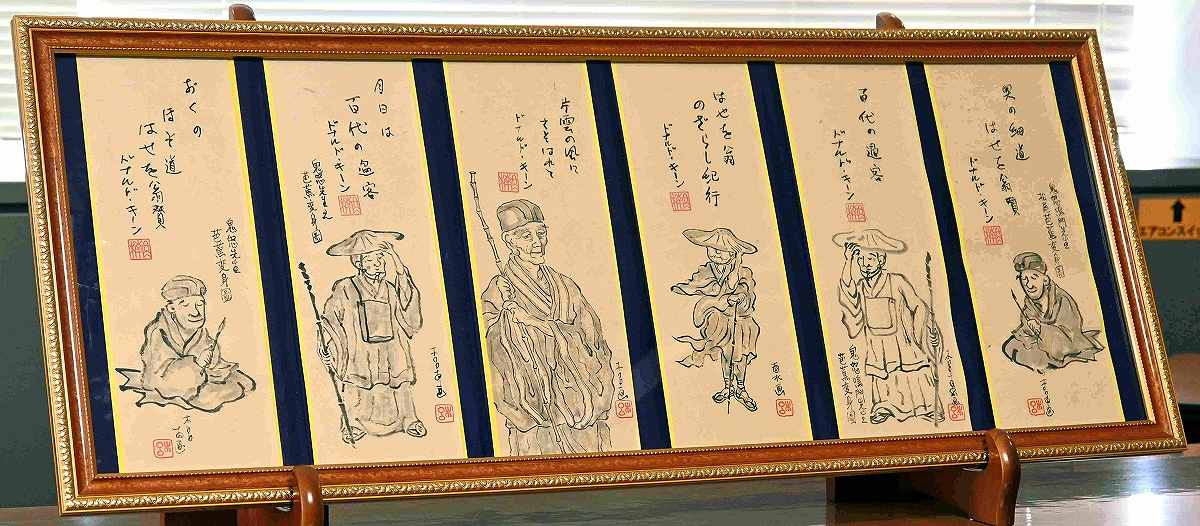
Calligraphy and paintings donated by Kiro Uehara
On Saturday morning, prior to the talk, Uehara donated six artworks to the city of Soka, each of them combining Keene’s calligraphy and Uehara’s haiga — pictures that are usually attached to a haiku. Keene’s calligraphy, written while visiting Niigata, is of words related to Basho, such as “Oku no Hosomichi.”
Friendship in Soka

Soka Matsubara, a pine-lined riverside walkway, stretches about 1.5 kilometers in Soka.
In Soka, there is a pine tree-lined walkway called “Soka Matsubara,” which preserves the scenery through which Basho walked during the Edo period. The path of pine trees, said to have been created in the late 17th century, now stretches 1.5 kilometers along the Ayase River. After the World War II, the greenery was in danger of disappearing due to automobile exhaust emissions and pine tree diseases, but citizens volunteered to replant pine trees and were able to restore the area to its former glory. The area is now designated a national scenic beauty spot and is a source of local pride.
In 1988, Soka held the Oku no Hosomichi International Symposium, at which Keene gave the keynote speech, marking the beginning of his interaction with the citizens of Soka. The city later established a literary award for travelogues and essays on themes such as travel along the “Oku no Hosomichi” route, and Keene served as a member of its selection committee. The Japanese culture and arts facility Zensoan Hakutai no Kakaku, which the city opened in 2019 for citizens’ tea ceremonies and other events, was named by Keene.
The calligraphy and paintings donated by Uehara will be exhibited at the Zensoan. At the donation ceremony, Soka City Mayor Yuriko Yamakawa said: “‘Oku no Hosomichi’ and Mr. Donald Keene are indispensable to the promotion of culture and art in Soka. I would like to convey their value to children.”
"JN Specialities" POPULAR ARTICLE
-

The Japan News / Weekly Edition (12/12-12/18)
-

Noodle Dining Shunsai / Rich Oyster Ramen to Savor at Odasaga; Experienced 68-year-old Owner Creates Numerous Ramen Varieties
-

The Japan News / Weekly Edition (12/5-12/11)
-

People Keep Loved Ones’ Ashes Close in Special Jewelry, Small Urns as Unique Way to Memorialize Them
-

The Japan News / Weekly Edition (12/19-12/25)
JN ACCESS RANKING
-

Tokyo Economic Security Forum to Hold Inaugural Meeting Amid Tense Global Environment
-

Keidanren Chairman Yoshinobu Tsutsui Visits Kashiwazaki-Kariwa Nuclear Power Plant; Inspects New Emergency Safety System
-

Imports of Rare Earths from China Facing Delays, May Be Caused by Deterioration of Japan-China Relations
-

University of Tokyo Professor Discusses Japanese Economic Security in Interview Ahead of Forum
-

Japan Pulls out of Vietnam Nuclear Project, Complicating Hanoi’s Power Plans
